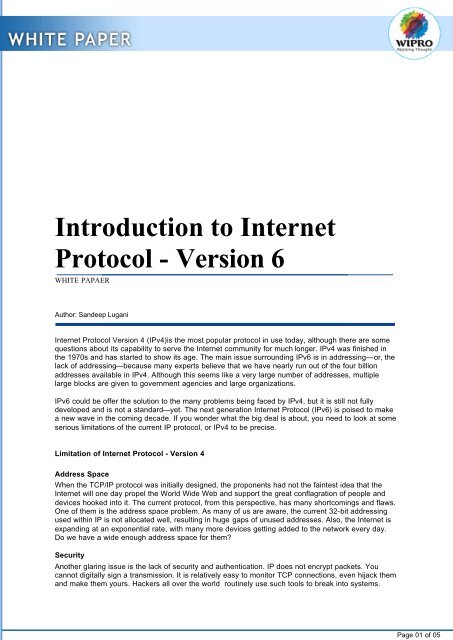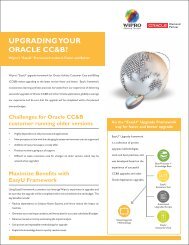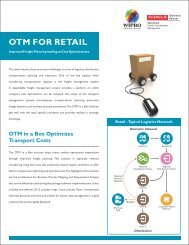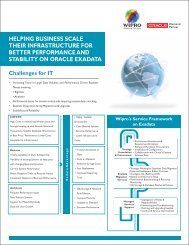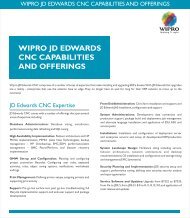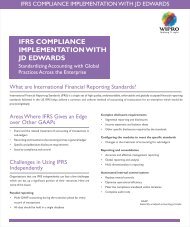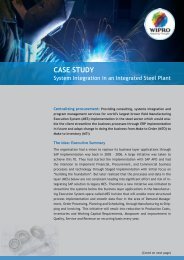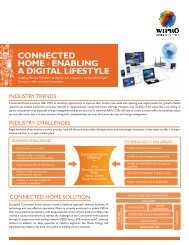Introduction to Internet Protocol - Version 6
Introduction to Internet Protocol - Version 6
Introduction to Internet Protocol - Version 6
You also want an ePaper? Increase the reach of your titles
YUMPU automatically turns print PDFs into web optimized ePapers that Google loves.
<strong>Introduction</strong> <strong>to</strong> <strong>Internet</strong><br />
Pro<strong>to</strong>col - <strong>Version</strong> 6<br />
WHITE PAPAER<br />
Author: Sandeep Lugani<br />
<strong>Internet</strong> Pro<strong>to</strong>col <strong>Version</strong> 4 (IPv4)is the most popular pro<strong>to</strong>col in use <strong>to</strong>day, although there are some<br />
questions about its capability <strong>to</strong> serve the <strong>Internet</strong> community for much longer. IPv4 was finished in<br />
the 1970s and has started <strong>to</strong> show its age. The main issue surrounding IPv6 is in addressing—or, the<br />
lack of addressing—because many experts believe that we have nearly run out of the four billion<br />
addresses available in IPv4. Although this seems like a very large number of addresses, multiple<br />
large blocks are given <strong>to</strong> government agencies and large organizations.<br />
IPv6 could be offer the solution <strong>to</strong> the many problems being faced by IPv4, but it is still not fully<br />
developed and is not a standard—yet. The next generation <strong>Internet</strong> Pro<strong>to</strong>col (IPv6) is poised <strong>to</strong> make<br />
a new wave in the coming decade. If you wonder what the big deal is about, you need <strong>to</strong> look at some<br />
serious limitations of the current IP pro<strong>to</strong>col, or IPv4 <strong>to</strong> be precise.<br />
Limitation of <strong>Internet</strong> Pro<strong>to</strong>col - <strong>Version</strong> 4<br />
Address Space<br />
When the TCP/IP pro<strong>to</strong>col was initially designed, the proponents had not the faintest idea that the<br />
<strong>Internet</strong> will one day propel the World Wide Web and support the great conflagration of people and<br />
devices hooked in<strong>to</strong> it. The current pro<strong>to</strong>col, from this perspective, has many shortcomings and flaws.<br />
One of them is the address space problem. As many of us are aware, the current 32-bit addressing<br />
used within IP is not allocated well, resulting in huge gaps of unused addresses. Also, the <strong>Internet</strong> is<br />
expanding at an exponential rate, with many more devices getting added <strong>to</strong> the network every day.<br />
Do we have a wide enough address space for them?<br />
Security<br />
Another glaring issue is the lack of security and authentication. IP does not encrypt packets. You<br />
cannot digitally sign a transmission. It is relatively easy <strong>to</strong> moni<strong>to</strong>r TCP connections, even hijack them<br />
and make them yours. Hackers all over the world routinely use such <strong>to</strong>ols <strong>to</strong> break in<strong>to</strong> systems.<br />
Page 01 of 05
Most pro<strong>to</strong>cols that require passwords over IP connections use clear text passwords. Why not<br />
encrypt such passwords? There are many additional add on software that can be used <strong>to</strong> surmount<br />
some of these problems, but the problem itself originates with the pro<strong>to</strong>col that belongs in the middle<br />
ages - when compared with <strong>to</strong>day's needs and standards.<br />
QOS<br />
If you stream an audio or video over the Web, there is no guarantee that you will have enough<br />
network bandwidth consistently <strong>to</strong> deliver the goods. In addition, the <strong>Internet</strong> <strong>to</strong>day doesn't have a<br />
structure that reflects IP address allocation, thus requiring huge routing tables <strong>to</strong> be maintained by<br />
routers. Network congestion abounds. Can it deliver the goods as technology races on? Thus is the<br />
status with IP version 4 (IPv4) that is in use <strong>to</strong>day.<br />
<strong>Internet</strong> Pro<strong>to</strong>col - <strong>Version</strong> 6<br />
IP version 6 or IPv6 is also known as IPng - (ng for new/next generation). The changes from IPv4 <strong>to</strong><br />
IPv6 fall under the major categories described below.<br />
Expanded Addressing Capabilities<br />
IPv6 increas es the IP address size from 32 bits <strong>to</strong> 128 bits, <strong>to</strong> support more levels of addressing<br />
hierarchy, a much greater number of addressable nodes, and simpler au<strong>to</strong>-configuration of<br />
addresses. The scalability of multicast routing is improved by adding a "scope" field <strong>to</strong> multicast<br />
addresses. A new type of address called an "anycast address" is defined, and can used <strong>to</strong> send a<br />
packet <strong>to</strong> any one of a group of nodes.<br />
Header Format Simplification<br />
Some IPv4 header fields have been dropped or made optional, <strong>to</strong> reduce the common-case<br />
processing cost of packet handling and <strong>to</strong> limit the bandwidth cost of the IPv6 header.<br />
Improved Support for Extensions and Options<br />
Changes in the way IP header options are encoded allows for more efficient forwarding, less<br />
stringent limits on the length of options, and greater flexibility for introducing new options in the future.<br />
Flow Labeling Capability<br />
A new capability is added <strong>to</strong> enable the labeling of packets belonging <strong>to</strong> particular traffic "flows" for<br />
which the sender requests special handling, such as non-default quality of service or "real-time"<br />
service.<br />
Authentication and Privacy Capabilities<br />
Extensions <strong>to</strong> support authentication, data integrity, and (optional) data confidentiality are specified for<br />
IPv6<br />
Description of <strong>Internet</strong> Pro<strong>to</strong>col - <strong>Version</strong> 6 Packet Header<br />
The format consists of <strong>Version</strong>, Class, Flow Label, Payload Length, Next Header, Hop Limit, Source<br />
Address, Destination Address, Data, and Payload fields.<br />
4 bits<br />
version<br />
16 bits<br />
Payload Length<br />
8 bits<br />
Traffic Class<br />
128 bits<br />
Source Address<br />
126 bits<br />
Destination Address<br />
8 bits<br />
Next Header<br />
24 bit<br />
Flow Label<br />
8 bits<br />
Hop Limit<br />
Page 02 of 05
Address Description<br />
Expanded addressing moves us from 32-bit address <strong>to</strong> a 128-bit addressing method. It also provides<br />
newer unicast and broadcasting methods, injects hexadecimal in<strong>to</strong> the IP address, and moves from<br />
using "." <strong>to</strong> using ":" as delimiters<br />
An IPv6 address is represented as 8 16-bit numbers in hexadecimal, like<br />
FEDC:BA98:0:0:0:BA98:7654:3210. It is not possible <strong>to</strong> remember these. And you don't have <strong>to</strong>. The<br />
DNS service will be modified <strong>to</strong> handle both 32-bit and 128-bit addresses. Also, an IPv6 address can<br />
be dynamically built when you plug in a device, by sensing the network address from the network you<br />
are connecting <strong>to</strong>, and then using your ethernet card's address (or the hardware address of whatever<br />
interface you are using) <strong>to</strong> build an IPv6 address. Thus you can reconfigure au<strong>to</strong>matically when<br />
moving from place <strong>to</strong> place. Your IPv6 addresses also change.<br />
Routing with <strong>Internet</strong> Pro<strong>to</strong>col - Versi on 6<br />
Routing has been <strong>to</strong>tally reworked <strong>to</strong> build hierarchies. That is, the IPv6 address itself tells the<br />
network where exactly <strong>to</strong> deliver the packets. These addresses will be portioned out <strong>to</strong> various ISPs<br />
and regula<strong>to</strong>ry bodies and a huge chunk kept in reserve. This also means that your IPv6 address will<br />
change when you move <strong>to</strong> another ISP (this is currently effective due <strong>to</strong> CIDR - classless InterDomain<br />
routing - which was invented <strong>to</strong> temporarily surmount the huge problems with addressing and routing<br />
tables).<br />
Anycast<br />
Broadcasting is done away with in IPv6. Only multi-casting is present. There is also an "anycast"<br />
feature where multiple devices listen on the same address, but the packet will be sent <strong>to</strong> only one, the<br />
"nearest" device. Currently this definition can be used only by routers. This would allow, for example,<br />
the Microsoft Network worldwide <strong>to</strong> use the same IPv6 address for ALL its routers. Your packet will go<br />
<strong>to</strong> the NEAREST router depending on which part of the world you are currently located in. Combined<br />
with plug-and-play, this is ideal for mobile devices.<br />
Jumbograms<br />
IPv6 datagrams can be Jumbograms (up<strong>to</strong> 4 billion bytes long)!. This is for better resource utilization<br />
in very fast networks (possibly intranets). You can "tunnel" IPv6 packets through IPv4 networks using<br />
machines that have "dual stacks" (running both IPv6 & IPv4) at the edge of the network. You can also<br />
tunnel IPv4 packets through an IPv6 network by using special addressing schemes on the IPv6<br />
network edges. However, <strong>to</strong> make full use of IPv6 features - including security and quality-of-service<br />
(QoS) - currently running applications will have <strong>to</strong> be modified. The socket APIs will expand, and<br />
many of the higher level abstractions can change <strong>to</strong> accommodate IPv6 features and addressing.<br />
QOS<br />
Quality of service (QOS) is a very important feature of IPv6. In fact, this is what has made ATM<br />
networks popular. IPv6 makes it possible <strong>to</strong> make network bandwidth reservations on traffic flows. A<br />
pro<strong>to</strong>col known as RSVP (Resource Reservation Pro<strong>to</strong>col) is invoked here. Essentially, all routers in<br />
the path recognize and honor flow-reservations and expedite or slow down packets as required, <strong>to</strong><br />
meet bandwidth guarantees. They can also timeout and free up resources that are unused. RSVP<br />
can be applied <strong>to</strong> multicast as well! The end result is that multimedia streaming applications may<br />
reserve network bandwidth and proceed without worrying about delivery hassles.<br />
Obstacles <strong>to</strong> <strong>Internet</strong> Pro<strong>to</strong>col - <strong>Version</strong> 6 Deployment<br />
There are a number of obstacles <strong>to</strong> widespread deployment of IPv6. Primary among them is the<br />
comfort level with existing solutions and the pain of changing networks that currently work (even<br />
though they contain many "workarounds" <strong>to</strong> overcome IPv4's limitations). The obstacles for IPV6 are<br />
based on technological as well as business reasons. If the migration is seen as a wave that must<br />
include end users, vendors and service providers, it becomes clear that each group has its own set of<br />
reasons <strong>to</strong> hesitate before embracing IPv6.<br />
US vs. the Rest of the World<br />
The 20 th century has been characterized by US leadership in technology. The ongoing recession in<br />
US and Sept, 11 disaster has hit the economy and prevented Network Managers from new<br />
Page 03 of 05
investments in Technology. Several trends, including the PC wave, started in the US and then<br />
spread throughout the world. The situation is likely <strong>to</strong> be quite different when it comes <strong>to</strong> IPv6<br />
because US companies have done quite well when it comes <strong>to</strong> their allocation of IPv4 addresses<br />
compared <strong>to</strong> the rest of the world. While European and Asian companies are motivated <strong>to</strong> migrate<br />
because of a shortage of IP addresses. Major US companies often still have blocks of addresses they<br />
have never used. It should be pointed out that smaller US companies that grow rapidly are faced with<br />
the problem of insufficient addresses, but they often find workarounds for this problem.<br />
No "Killer Application" for <strong>Internet</strong> Pro<strong>to</strong>col - <strong>Version</strong> 6<br />
Most technology upgrades are driven by a "killer application." Unless increased address space itself is<br />
viewed as a "killer application," many opponents of IPv6 argue that there is no compelling reason <strong>to</strong><br />
migrate. This by itself, is not so enticing and becomes a non-argument when migration is proposed.<br />
Few Existing Compliant Products<br />
While there have been some early products, such as Sendmail, that support IPv6, there has not been<br />
an explosion in IPv6 products. Only Microsoft has begin shipping IPv6-compliant products, there will<br />
not be awareness in the market for IPV6 that their products have <strong>to</strong> support this new pro<strong>to</strong>col.<br />
Cost Is a Fac<strong>to</strong>r<br />
For any new technology migration, cost always play a crucial role. The world will not necessarily<br />
decide one day <strong>to</strong> migrate en masse <strong>to</strong> IPv6 - the problem of supporting two pro<strong>to</strong>cols means<br />
additional expense as well as network overhead for companies. Whether that means supporting dual<br />
pro<strong>to</strong>col stacks, gateways or encapsulation of packets, there will be significant cost for large<br />
enterprises <strong>to</strong> migrate <strong>to</strong> IPv6.<br />
Network Address Translation (NAT)<br />
Majority of the companies simply advertises one address <strong>to</strong> the outside world and then translates that<br />
address in<strong>to</strong> the appropriate address internally. NAT provides greater security since the real<br />
addresses of internal sites are hidden behind the real IPV4 address. Due <strong>to</strong> this reason, companies<br />
have opted <strong>to</strong> use private addressing internally and not even worry about possible duplication of IP<br />
addresses with external users since those addresses are never routed outside and are never seen<br />
outside the firewall.<br />
Opportunities in India/APAC<br />
Market trend and Growth Scenerio<br />
Itappears that the original timetable for IPv6 adoption has been set back by at least 18 months. It will<br />
be at least the third quarter of 2006 before IPv6 nodes surpass IPv4 nodes<br />
The wireless industry can be the strongest driving force for the rapid migration from IPv4 <strong>to</strong> IPv6<br />
because of the number of IP addresses needed for <strong>Internet</strong> access from third-generation cell phones.<br />
This trend seemed inevitable last year when the Third Generation Partnership Program (3GPP), a<br />
European wireless organization, adopted IPv6 as its standard.<br />
For the past several months, service providers have cut back on their expenditures as evidenced in<br />
revenue declines for vendors such as Cisco and Nortel. There is very little pressure on service<br />
providers <strong>to</strong> add IPv6 because many enterprises have postponed IT projects until the economy<br />
improves.<br />
The significant lack of interest in IPv6 in the United States implies that growth will take place first in<br />
parts of the world where IP addresses are in short supply. There are signs that the Asia-Pacific will<br />
be a leader in the migration <strong>to</strong> IPv6. Japan currently has a serious lack of IPv6 addresses so it<br />
should come as no surprise that the Japanese government has set a deadline of 2005 for the<br />
adoption of IPv6. NTT DoCoMo has plans <strong>to</strong> roll out third-generation wireless services later this year.<br />
There is also significant IPv6 activity in Hong Kong, China and Australia. Europe will follow, but its<br />
migration will be predicated on how quickly the wireless industry turns healthy. Wireless <strong>Internet</strong><br />
access remains the key driver that could force European providers <strong>to</strong> offer IPv6 services.<br />
Page 04 of 05
INTERNET PROTOCOL - VERSION 6 Growth Statistics<br />
It is positioned by independent agencies that the number of installed IPv6 nodes will not surpass the<br />
number of installed IPv4 nodes until the third quarter of 2006. Should economic conditions not<br />
rebound until 2002, the wireless industry will have little chance of launching successful thirdgeneration<br />
wireless services. The lack of a large installed base of European wireless <strong>Internet</strong> users<br />
will mean a limited need for more IP addresses and a roadblock <strong>to</strong> IPv6’s chances of overtaking IPv4.<br />
Under such conditions, IPv6 would not attain majority status until 2007.<br />
Vendors<br />
Cisco has already announced that it will support IPv6 beginning with its IOS release 12.2(1)T and that<br />
the IPv6 support will also be available as a free download <strong>to</strong> cus<strong>to</strong>mers with maintenance contracts.<br />
The vendor is adding IPv6 support later this year for its carrier-class 7600 and 12000 routers and its<br />
Catalyst 6000 enterprise switches. Microsoft has reiterated recently that it will support IPv6 in its<br />
Windows XP<br />
Summary<br />
Over the next 10-15 years, the <strong>Internet</strong> & the Web would probably evolve beyond our imagination.<br />
IPv6 tries <strong>to</strong> forecast that picture and ensure that many of the possible requirements of the future are<br />
addressed. It also has <strong>to</strong> maintain inter-operability with legacy networks like those using Novell IPX.<br />
Think of this as something like a transition from an Intel 8088 chip <strong>to</strong> a Pentium IV, maintaining<br />
compatibility, but vastly enhancing the scope.<br />
Performance-wise, IPv6 is expected <strong>to</strong> give a real boost compared <strong>to</strong> IPv4, due <strong>to</strong> efficient routing,<br />
good packet structure, Quality-of-service. The transition stage requires that most routers upgrade<br />
over a short time <strong>to</strong> new and faster technology, and of course any future technological innovations<br />
expected on the <strong>Internet</strong>.<br />
About Wipro Infotech<br />
Wipro Infotech, a division of Wipro Limited (NYSE:WIT), provides enterprise cus<strong>to</strong>mers with<br />
high value Information Technology Products, Services and Solutions in India, and provides<br />
Technology & Software Services in the Asia Pacific and the Middle East. Wipro Infotech's<br />
position of leadership in this business is built on a strong foundation of Quality processes,<br />
including Six Sigma, ISO, Knowledge Management & People processes (PCMM- People<br />
Capability Maturity Matrix). Headquartered at Bangalore, India, Wipro Infotech has business<br />
offices in Dubai, Saudi Arabia, Singapore, Sydney, Taipei & Hong Kong in the Asia Pacific &<br />
the Middle East.<br />
© Copyright 2002.Wipro Infotech. All rights reserved. No part of this document may be<br />
reproduced, s<strong>to</strong>red in a retrieval system, or transmitted in any form, by any means, electronic,<br />
mechanical, pho<strong>to</strong>copying, recording, or otherwise, without express permission from Wipro<br />
Infotech. Specifications subject <strong>to</strong> change without notice. All other trademarks mentioned<br />
herein are the properties of their respective owners.<br />
India- Corporate Headquarters Asia Pacific<br />
Wipro Infotech Wipro Limited (Singapore Branch)<br />
Doddakannelli, Sarjapur Road, 22, Malaca Street #06-01<br />
Bangalore-560 035 Royal Brothers Building<br />
Tel: 91-80-8440011 Singapore -048980<br />
Fax: 91-80-8440216 Tel: 65- 5320604<br />
Fax: 65- 5327610<br />
Middle East Visit us at: www.wipro.co.in<br />
Wipro Infotech E-mail: info@wipro.co.in<br />
Office No.124, Building 1,<br />
First Floor, Dubai <strong>Internet</strong> City,<br />
PO Box 500119, Dubai,<br />
United Arab Emirates<br />
Phone: 9714-3913480<br />
Fax: 9714-3913482<br />
Page 05 of 05


